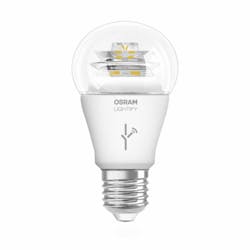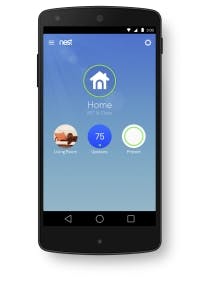The German lamp maker's Lightify line now works with the Nest home control system, owned by the search-engine provider.
As Osram seeks new owners for its lamp business, it has smartened up its product offerings, making its Lightify range of smart LED lamps compatible with Google's Nest home control system.
Osram said the Lightify line has joined the “Works with Nest” program in the UK and Ireland, with other countries to follow soon.
Interested in more articles & announcements on smart LED lamps and controls?
Lightify is Osram's offering in what the residential market calls “smart bulbs” that do things generally not possible with conventional lighting. Users can tap apps on their phones and tablets to turn lights on or off, brighten or dim them, or change colors to suit moods — all from the same room as the lights, or from around the world via the Internet (to, say, deter burglars).
Consumers can also program them in advance to do those things at certain times of the day, or to flash as security alarms, smoke detectors, sports or stock price alerts.
With the new deal in the UK and Ireland, Osram users now have the option of tying those smart LED lamps into Google's Nest thermostat and home automation device, which wirelessly connects to boilers, furnaces, doors, lights, washing machines, and phones, among other items. Nest is potentially a key hub in the fledgling Internet of Things (IoT), allowing people to program and operate appliances from afar, and to set up “if-then” scenarios (if an intruder walks in, flash the lights and sound the alarm, for instance).
“Nest users can use any product within the Lightify family to create scenes and integrate them with the 'home and away' scenes of Nest,” Osram said. “When using the 'home and away' functions, users can choose from any of their existing Lightify scenes.”
Rival smart LED lamps include Hue from Philips, Link from GE, the Connected Cree LED Bulb, the LIFX bulb from the eponymous Redwood City, CA startup, and others. Philips has extended Hue's capabilities into the entertainment world, syncing lighting to match the action in the TV series “12 Monkeys.”
Smart bulbs cost a lot more than a standard LED lamp. Osram lists the Lightify lamp in the UK at £40 (about $60) for a full color-changing model. The Tesco website is selling Lightify lamps for between £25 and £31 depending on the version, while Osram's “standard” LED lamps generally sell for between £6 ($9) and £10 ($15) depending on the model and packaging.
Lightify also requires a small gateway box that plugs into a wall socket and serves three purposes — it receives instructions from the app, transmits instructions to the light, and sends and receives instructions to and from the Internet via a wireless connection. Tesco is selling the gateway for £40.
Market research firm ABI late last year forecasted that vendors would sell a quarter of a billion smart bulbs annually by 2020.
Meanwhile, as Osram announced in April, it “intends to transfer the general lighting lamps business into an independent structure.” The transaction could include selling the $2.5B general lamp business. Lighting giant Philips is attempting a similar move. Some observers also expect GE to sell off its conventional lighting and home LED operations in the wake of its recent reorganization in which it moved commercial LED lighting into a new energy services division called Current, Powered by GE.
Osram is placing its focus on components and automotive lighting. It is scheduled to report results on Nov. 11 for its fiscal year ended Sept. 30.
MARK HALPERis a freelance energy, technology, and business journalist ([email protected]).
Related articles:
Philips Lighting adds dimmer control for ZigBee-based Hue LED lamps
GE Lighting unveils wireless Link LED lamp family and starter kit
Cree delivers connected LED lamp based on ZigBee wireless standard
Qualcomm takes CES stage to promote wireless LED lamp technology








